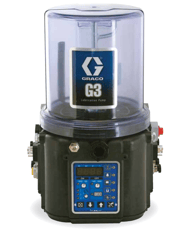
Electric Lubrication Pumps
Electric lubrication pumps are not new, but they have become more popular in the last decade due to their ease of installation, better controller interfaces and lower cost. Two of the more popular electric pumps in the Industrial Lubrication Equipment space are the G3 from Graco and P653S from Lincoln. Both pumps are well built and, in our experience, suited for a multitude of industrial applications.
Lubrication Pump Operating Cycles: Graco G3 vs. Lincoln P653S
Both pumps are offered in common DC and AC voltages, and they’re each available in a variety of reservoir sizes; 4, 8, 15 & 20 liter for the P653S and 2, 4, 8, 12 & 16 for G3. And they have similar constraints in their operating cycles. The G3 is limited to a 30-minute pumping cycle while the P653S is limited to a 12-minute pumping cycle. And after pumping to their maximum allowable time, the G3 must rest for twice as long as its run cycle and the P653S must rest for 4-minutes. These “on” and “off” cycles are critical factors when designing a lubrication system as they cannot be exceeded.
Now to the differences.
The Differences In These Electric Lubrication Pumps
 Flexibility: The P653S is designed exclusively for single-line parallel systems (i.e. injectors) with a built-in vent valve. The G3 can be deployed for either a single-line parallel or a series progressive system. There are separately sold vent-valves for the single-line parallel systems and pressure relief valves for the series progressive systems.
Flexibility: The P653S is designed exclusively for single-line parallel systems (i.e. injectors) with a built-in vent valve. The G3 can be deployed for either a single-line parallel or a series progressive system. There are separately sold vent-valves for the single-line parallel systems and pressure relief valves for the series progressive systems.
Models: The Lincoln P653S comes in one model with a standard controller. You cannot purchase a “dumb” P653S to be controlled by a PLC. The Graco G3 is offered in three models; Standard, Plus and Max. The different models mean you can operate the pump from your PLC or program the pump itself to operate independently. In this category, the G3 is the winner because of the ability to mate a G3 Standard to a customer’s PLC allows the lubrication pump to be in the same operating mode as the equipment it is lubricating.
 Pressure: The G3 is rate for 5,100 maximum psi. The P653S is rate for 3,500 psi with an internal pressure switch or 4,100 with an internal pressure transducer. The 1,000-1,600-psi difference may not seem like much for a lubrication system, but pressure loss needs to be calculated to properly design a single line parallel (injector) system. The G3 has an advantage here but is not a clear winner, because…
Pressure: The G3 is rate for 5,100 maximum psi. The P653S is rate for 3,500 psi with an internal pressure switch or 4,100 with an internal pressure transducer. The 1,000-1,600-psi difference may not seem like much for a lubrication system, but pressure loss needs to be calculated to properly design a single line parallel (injector) system. The G3 has an advantage here but is not a clear winner, because…
Volume output: The G3 is capable of delivering a maximum of 0.25 cu in of grease per minute while the P653S is capable of 1.5 cu in per minute; a significantly greater amount. Even when factoring the shorter operating time (12 minutes) of the P653S, the Lincoln pump is capable of a maximum output of 18 cu in before if must pause whereas the Graco is limited to 7.5 cu in. In this category, Lincoln is the winner. The ability to deliver more grease more quickly is important for lubrication systems with more points.
Takeaways From Comparing Electric Lubrication Pumps
When choosing an electric pump for your lubrication system remember to look at all of the variables involved, including bearing type, bearing lubrication amount, supply line diameter and length, and distribution valve options. All of these (and a few more) matter in creating a lubrication system that best meets a customer’s needs.
We’re thankful to be an authorized distributor for both Graco and SKF/Lincoln.







